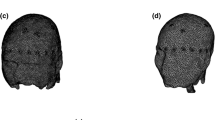Abstract
In this study, solid, stable, and cost-effective optical phantoms of scalp–skull, white matter and grey matter are developed by inverse method. To begin with, to obtain a range of optical parameters, absorption and reduced scattering coefficients (μa and \( {\mu }\ifmmode{'}\else$'$\fi_{{\text{s}}} , \) respectively), 20 homogeneous phantoms were made of paraffin wax by using optically contrast black and highly scattering white colouring materials in different combination. By comparing the measured reflectance values for each phantom got from the four channel reflectometer with that obtained from steady-state diffusion equation, the values of μa and \( {\mu }\ifmmode{'}\else$'$\fi_{{\text{s}}} \) were determined. Next, phantoms which exhibit specific optical properties of scalp–skull, white and grey matter are developed iteratively by comparing actual reflectance measurements got by adjusting the colour concentration with the predicted reflectance values from the diffusion equation. This is done as follows: to obtain μa of 0.04 mm−1 for scalp–skull, 9.5 mg of black dye per 100 ml of wax added since more attenuation of light occurs in bone tissue. To obtain a \( {\mu }\ifmmode{'}\else$'$\fi_{{\text{s}}} \) 6.0 mm−1 for white matter in brain tissue, 190 mg of white dye per 100 ml of wax was used to facilitate more scatter of light. The colour concentrations of phantoms were then adjusted to obtain the predetermined values of optical parameters for scalp–skull, grey and white matter.





Similar content being viewed by others
References
Bevilacqua F, Piguet D, Marquet P, Gross MJ, Tromberg BJ, Depeursinge C (1999) In vivo local determination of tissue optical properties: applications to human brain. Appl Opt 38:4939–4950
Cheong W, Prahl SA, Welch AJ (1990) A review of the optical properties of biological tissues. IEEE J Quantum Electron 26:2166–2185
Cubeddu R, Pifferi A, Taroni P, Torricelli A, Valentini G (1997) A solid tissue phantom for photon migration studies. Phys Med Biol 42:1971–1979
Farrell TJ, Patterson MS, Wilson BC (1992) A diffusion theory model of spatially resolved, steady-state diffusion reflectance for the non-invasive determination of tissue optical properties. Med Phys 19:879–888
Firbank M, Oda M, Delpy DT (1995) An improved design for a stable and reproducible material for use in near infra-red spectroscopy and imaging. Phys Med Biol 40:955–961
Ishimaru A (1978) Wave propagation and scattering in random media. vol 1. Academic, New York, NY
Ntziachristos V, Ma X, Yodh AG, Chance B (1999) Multichannel photon counting instrument for spatially resolved near infrared spectroscopy. Rev Sci Instrum 70:193–201
Prahlad Rao K, Radhakrishnan S, Ramasubba Reddy M (2003) Optical imaging of an abnormal region in a scattering medium. World Congress on Medical Physics and Biomedical Engineering, Sydney, 24–29 August
Taddeucci A, Martelli F, Barilli M, Ferrari M, Zaccanti G (1996) Optical properties of brain tissue. J Biomed Opt 1:117–123
Yamashita Y, Maki A, Koizumi H (1996) Near-infrared topographic measurement system: imaging of absorbers localized in a scattering medium. Rev Sci Instrum 67:730–732
Yodh A, Chance B (1995) Spectroscopy and imaging with diffusing light. Phys Today 48:34–40
Author information
Authors and Affiliations
Corresponding author
Rights and permissions
About this article
Cite this article
Rao, K.P., Radhakrishnan, S. & Reddy, M.R. Brain tissue phantoms for optical near infrared imaging. Exp Brain Res 170, 433–437 (2006). https://doi.org/10.1007/s00221-005-0242-4
Received:
Accepted:
Published:
Issue Date:
DOI: https://doi.org/10.1007/s00221-005-0242-4




